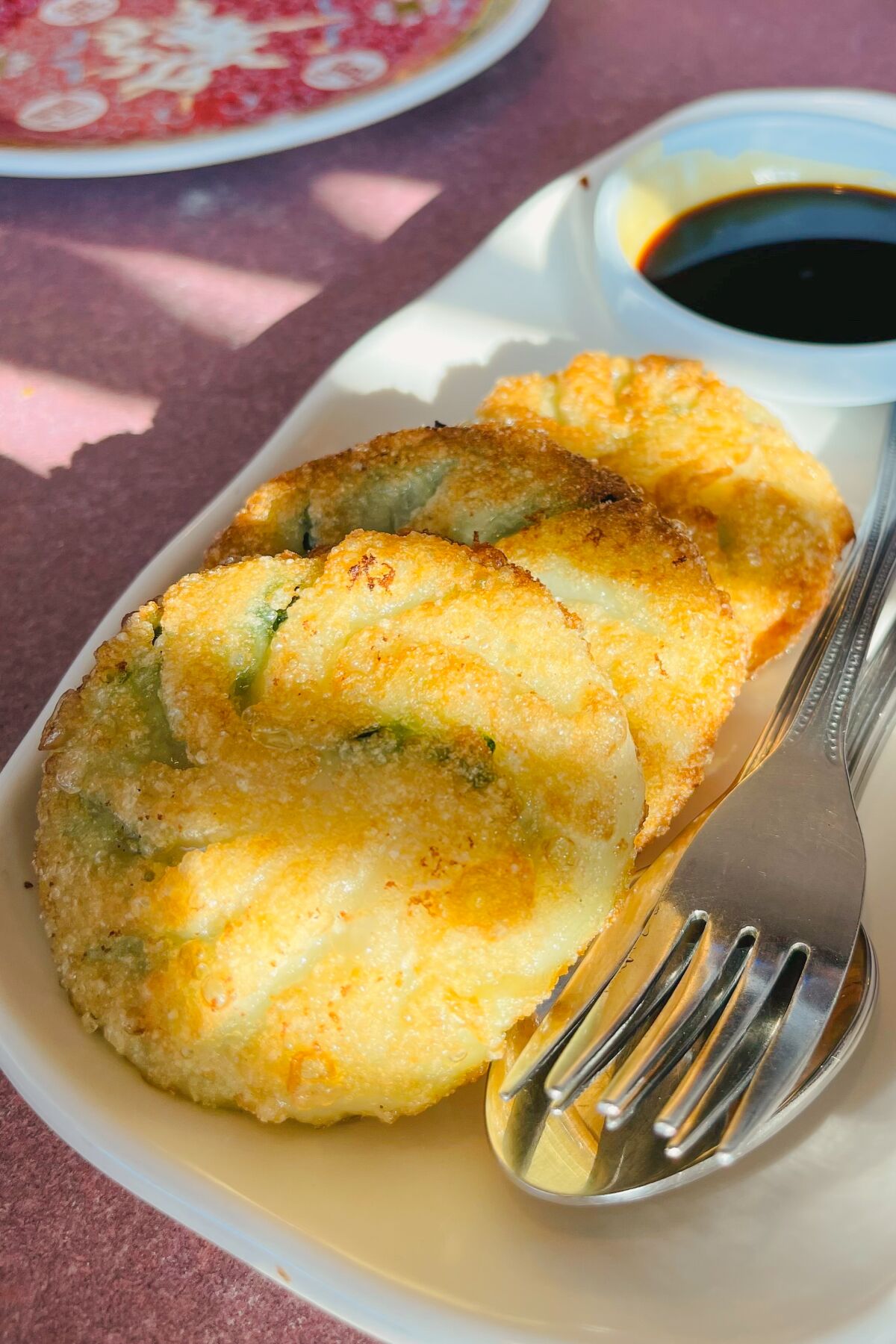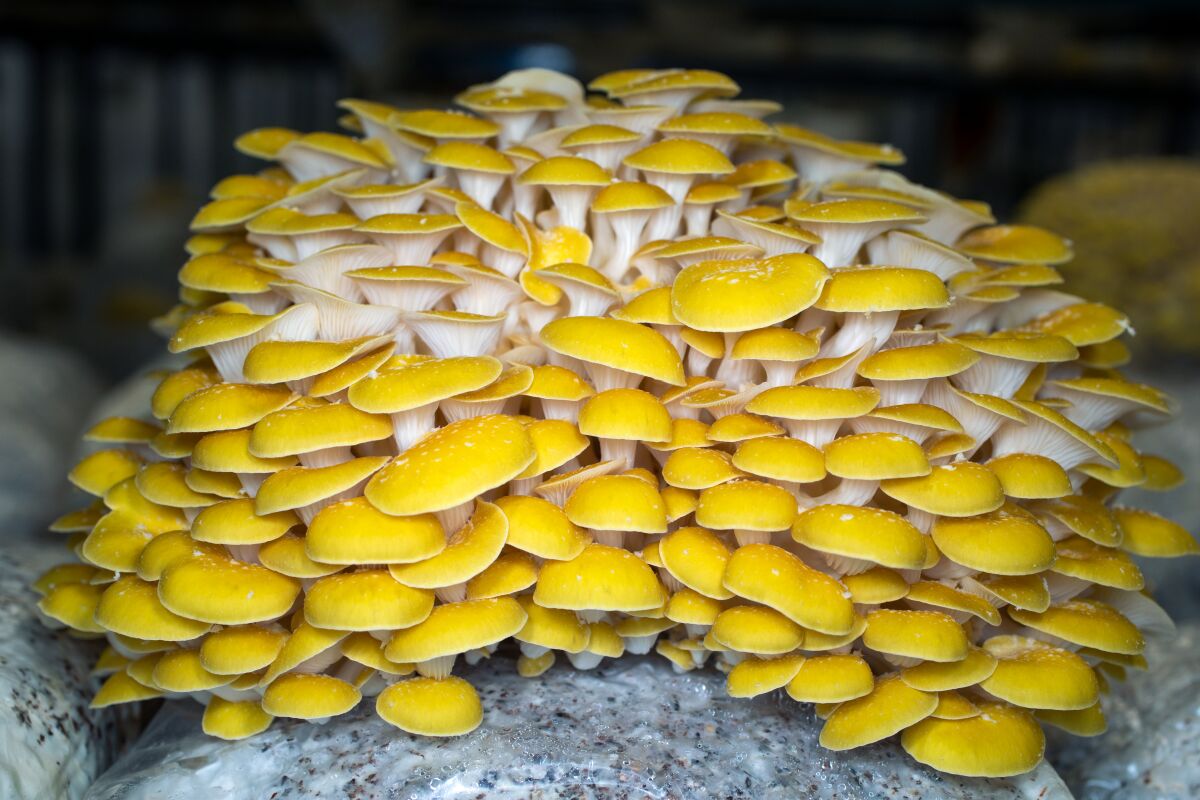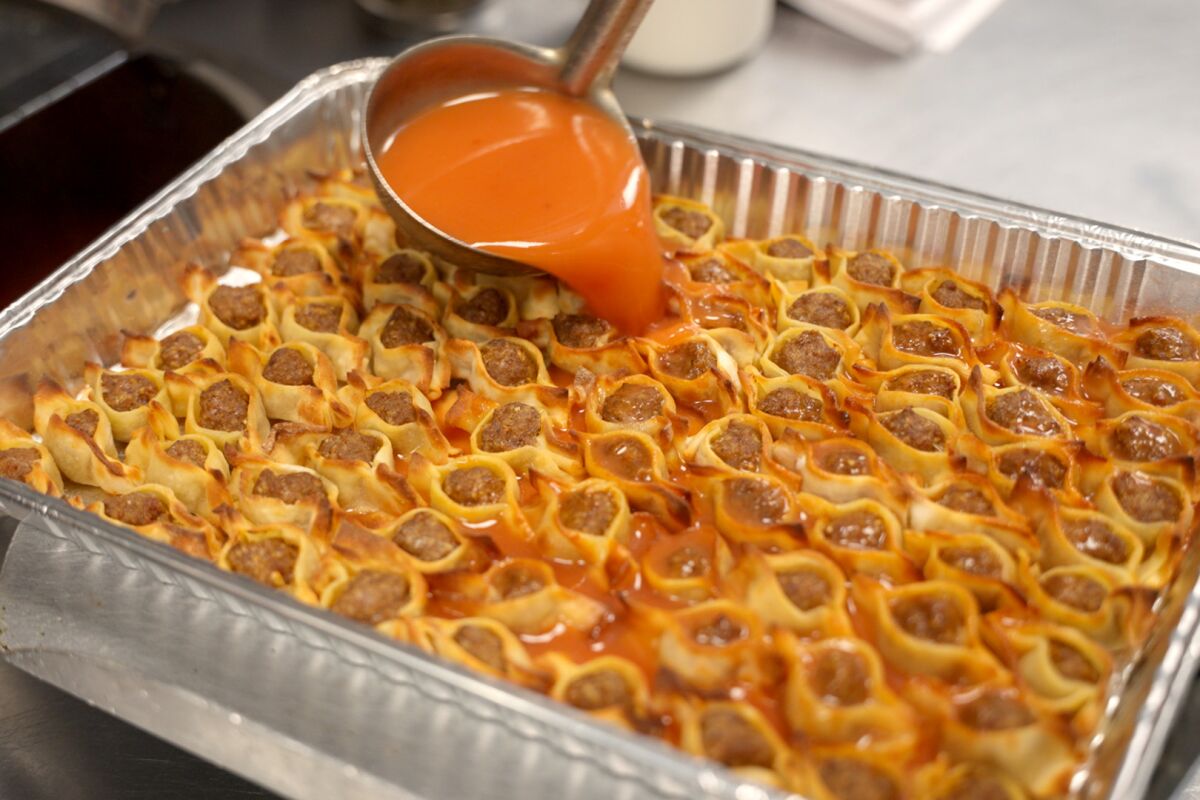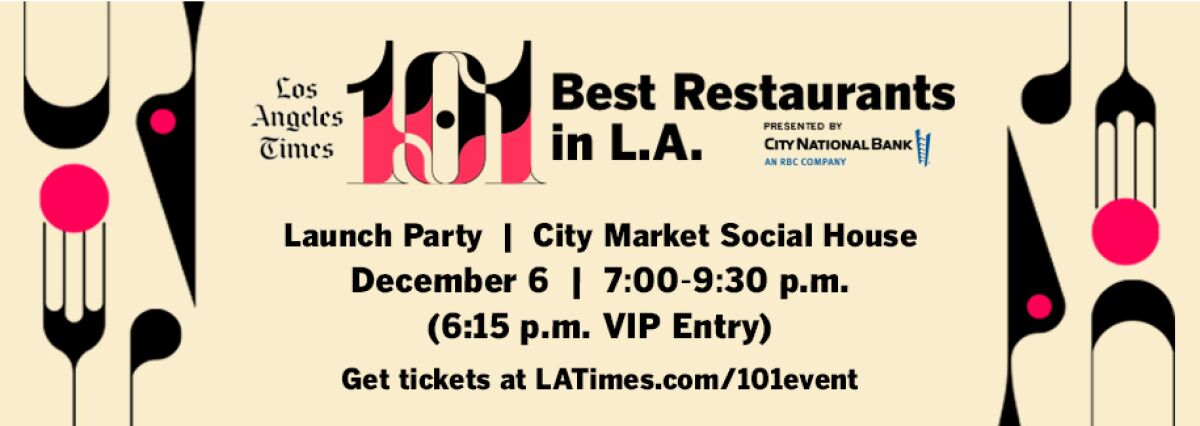3 Los Angeles restaurants to dine at after vacation
An unusual mushroom farm, a chef who hates trash cans, manta for all, Thanksgiving classics and waiting for froufrou. I’m Laurie Ochoa, general manager of L.A. Times Food, with this week’s Tasting Notes.
Taste of home
Thai spaghetti with green curry and leek cakes at Siam Sunset in Hollywood.
(Laurie Ochoa / Los Angeles Times)
When you come back from a long trip, what’s the first thing you want to eat? What is the food that makes you happy to be home? Here in Los Angeles, there isn’t one cuisine that defines us, but many foods from many different places.
When I returned recently from France and Italy, a trip filled with many incredible meals, I woke up way too early and headed with a fellow jet-lagged traveler to Siam Sunset, which opens for early birds craving congee at 6 a.m. Knowing that I’d be able to reach across the table for a spoonful or three of my pal’s fish porridge — plus a piece of the all-important Chinese doughnut, as Jean Trinh discussed last month — I ordered two comfort food dishes that I love at Siam Sunset. Thai spaghetti with green curry is soothing in its creaminess with just enough heat to awaken the senses after a long flight. And leek cakes have that excellent crisp-soft contrast with a fried outer layer that yields to the stretchy rice cake inner layer and the satisfying filling of chopped leeks.

Leek cakes at Siam Sunset in Hollywood.
(Laurie Ochoa / Los Angeles Times)
Sitting in the no-frills dining room tucked into the motel space that might otherwise house an ordinary coffee shop, I soaked up the early morning light that cast shadows on our table, sipped my Thai iced coffee and felt happy to be home.

The katsu curry plate at Katsu Sando in Chinatown.
(Laurie Ochoa / Los Angeles Times)
Hours later, I was catching up with my daughter, who was craving an egg salad sando. She’d been having sandos delivered throughout the pandemic from Katso Sando, but this time we went to the restaurant’s Chinatown home and were rewarded not just with the sando but a fantastic katsu curry plate. Of course, the gorgeously fried pork tasted even better than the delivery version, eaten moments after emerging from the kitchen. I used to love eating katsu curry at the now-closed Curry House in Little Tokyo with Isabel — she still has a Gudetama knit cap from a promotion they did with Gudetama’s face etched into the special meal’s soup and custard. Katso Sando’s version brought back good memories of those meals.
Enjoying this newsletter? Consider subscribing to the Los Angeles Times
Your support helps us deliver the news that matters most. Become a subscriber.
Then we had a showstopper of a shaved ice dessert when out came chef Daniel Son with a black-and-white kakigori topped with fried mochi dusted in toasted black-and-white sesame seeds and drizzled with black-and-white sesame syrup. It was a play on a deli black-and-white cookie and is just one more example that shows how L.A. cuisine pulls from many traditions.

Galbi jjim with cheese gets flamed at Sun Nong Dan in Koreatown.
(Laurie Ochoa / Los Angeles Times)
The next night, still not settling into anything close to a regular sleep pattern, I found myself eating a late-night Koreatown dinner of galbi jjim at Sun Nong Dan, one of L.A.’s rare 24-hour restaurants. You don’t really need to add cheese to the braised short ribs with thick rice noodles, but the night feels so much more festive when your dinner gets flamed at the table and the cheese melts so beautifully. As my late husband, Jonathan Gold, once wrote in this paper, “Galbi jjim at Sun Nong Dan is Hendrix shredding a Bob Dylan song or David Choe slapping paint onto a wall, all the sensations of the dish run through a distortion pedal and cranked up to 10.”
If doesn’t get more Los Angeles than that.
Where the mushrooms grow
I have very specific memories of the city of Vernon, which is where my mother worked at a trucking company when I was growing up. I remember the time she had to bring me and my sister along to a picket line when the Teamsters went on strike, the murals of idyllic farm life that belied the slaughterhouse activities of the Farmer John processing plant that’s shutting down next year, plus the smell of fertilizer that used to surround Bandini Mountain, the pile of manure that became famous for the 1980s TV commercial showing some poor guy skiing down the now-removed brown mound. But recently deputy food editor Betty Hallock found something wonderful and unexpected inside a Vernon warehouse: an urban mushroom farm.

Yellow oyster mushrooms, one of several varieties grown at Smallhold Mushrooms, a warehouse farm in Vernon.
(Myung J. Chun / Los Angeles Times)
“In a 34,000-square-foot building, on the same street as a producer of ready-mix concrete and a Dr Pepper distributor,” she writes in her feature about the company aiming to dominate the Southern California fungi scene, “Smallhold grows mushrooms of fantastical display and scale — several thousand pounds of mushrooms a week, or tens of thousands of pounds in the near future, if all goes as planned.” It’s all part of what Hallock calls “a mushroom revolution taking place on the grocery store shelves of Southern California.”
Even so, I think I’ll keep buying my mushrooms at Lily Balthazar’s stand at the Pasadena and Hollywood farmers markets, where she not only sells fantastic herbs from her ABC Rhubarb Farm, but otherworldly varieties of Bih Shah Farm mushrooms.
The restaurant without a trash can

Chef Douglas McMaster, of the “no-waste” restaurant Silo in London.
(Christina House / Los Angeles Times)
Can you operate a restaurant without a trash can? London chef Douglas McMaster does and he told Food staff writer Stephanie Breijo how and why he operates his restaurant Silo with no trash bins. “It’s very hard. It’s stressful, but it’s the right thing to do.”
McMaster was in town recently for L.A.’s first MAD Monday, part of a series of talks hosted for restaurant pros in Copenhagen by Noma chef Rene Redzepi’s MAD Foundation. McMaster’s talk on trying to run a zero-waste restaurant got us wondering what California chefs are doing in their kitchens to reduce waste. Her McMaster interview is the first of our Waste Not series, which will examine food and sustainability in restaurants and beyond.
Holiday party trick

Francine Yegiazaryan pours tomato sauce over a tray of manta.
(Cody Long / Los Angeles Times)
In the latest episode of “The Bucket List: Dumplings,” Jenn Harris tells us all about manta, the “open-style, meat-filled dumplings that resemble tiny boats, with a thin layer of dough wrapped around a small meatball in the center.” Sarkes Yegiazaryan, who runs the Manta Factory in Glendale, says to Harris that he “wants to make manta a household name.”
“I want people to remember manta,” he says. “The name hasn’t stuck yet. My mission is to make it stick.”
I can vouch for the greatness of manta. I’m lucky enough to live close to the Yegiazaryan’s Pasadena location of Su-Beoreg & Monta Factory and have often picked up trays of monta as an easy and delicious pot luck contribution. Something to keep in mind as the holiday party season starts up.
Meanwhile, in her weekly column of what she’s been eating all week, Harris asserts that Venezuelan pancakes are better than American pancakes. Read her argument in favor of Amara Cafe’s cachapas over diner hotcakes here.
Back to turkey basics

A classic Thanksgiving feast.
(Katrina Frederick / For The Times)
And speaking of holidays, Food columnist Ben Mims has put together a turkey-to-gravy guide on making a classic Thanksgiving feast. He includes how-to videos and will be answering reader’s Thanksgiving questions next week on our L.A. Times Food Instagram account.
Ludo’s new deal and more restaurant news
In addition to her column on the week’s restaurant openings — a new British pub from the group behind Mother Wolf and Ka’teen, a new bar from “Vanderpump Rules” cast members — Times staff writer Stephanie Breijo reports that Ludo and Krissy Lefebvre are breaking off from their eight-year partnership with Jon Shook and Vinny Dotolo’s J&V Group. “It feels good to buy something you believe in,” Ludo told Breijo about putting up the money to fully own his Petite Trois in Hollywood and Petite Trois Le Valley in Sherman Oaks. “I’m very, very excited for the future, and I want to make Petit Trois better still and push the envelope a little bit.”
Of course, what a lot of us want to know is whether the Lefebvres will reopen his tasting menu spot Trois Mec.
“It’s not now,” he tells Breijo, “but we never know. I miss that; I miss the French froufrou.”
We miss the froufrou too.

An unusual mushroom farm, a chef who hates trash cans, manta for all, Thanksgiving classics and waiting for froufrou. I’m Laurie Ochoa, general manager of L.A. Times Food, with this week’s Tasting Notes.
Taste of home

Thai spaghetti with green curry and leek cakes at Siam Sunset in Hollywood.
(Laurie Ochoa / Los Angeles Times)
When you come back from a long trip, what’s the first thing you want to eat? What is the food that makes you happy to be home? Here in Los Angeles, there isn’t one cuisine that defines us, but many foods from many different places.
When I returned recently from France and Italy, a trip filled with many incredible meals, I woke up way too early and headed with a fellow jet-lagged traveler to Siam Sunset, which opens for early birds craving congee at 6 a.m. Knowing that I’d be able to reach across the table for a spoonful or three of my pal’s fish porridge — plus a piece of the all-important Chinese doughnut, as Jean Trinh discussed last month — I ordered two comfort food dishes that I love at Siam Sunset. Thai spaghetti with green curry is soothing in its creaminess with just enough heat to awaken the senses after a long flight. And leek cakes have that excellent crisp-soft contrast with a fried outer layer that yields to the stretchy rice cake inner layer and the satisfying filling of chopped leeks.

Leek cakes at Siam Sunset in Hollywood.
(Laurie Ochoa / Los Angeles Times)
Sitting in the no-frills dining room tucked into the motel space that might otherwise house an ordinary coffee shop, I soaked up the early morning light that cast shadows on our table, sipped my Thai iced coffee and felt happy to be home.

The katsu curry plate at Katsu Sando in Chinatown.
(Laurie Ochoa / Los Angeles Times)
Hours later, I was catching up with my daughter, who was craving an egg salad sando. She’d been having sandos delivered throughout the pandemic from Katso Sando, but this time we went to the restaurant’s Chinatown home and were rewarded not just with the sando but a fantastic katsu curry plate. Of course, the gorgeously fried pork tasted even better than the delivery version, eaten moments after emerging from the kitchen. I used to love eating katsu curry at the now-closed Curry House in Little Tokyo with Isabel — she still has a Gudetama knit cap from a promotion they did with Gudetama’s face etched into the special meal’s soup and custard. Katso Sando’s version brought back good memories of those meals.
Enjoying this newsletter? Consider subscribing to the Los Angeles Times
Your support helps us deliver the news that matters most. Become a subscriber.
Then we had a showstopper of a shaved ice dessert when out came chef Daniel Son with a black-and-white kakigori topped with fried mochi dusted in toasted black-and-white sesame seeds and drizzled with black-and-white sesame syrup. It was a play on a deli black-and-white cookie and is just one more example that shows how L.A. cuisine pulls from many traditions.

Galbi jjim with cheese gets flamed at Sun Nong Dan in Koreatown.
(Laurie Ochoa / Los Angeles Times)
The next night, still not settling into anything close to a regular sleep pattern, I found myself eating a late-night Koreatown dinner of galbi jjim at Sun Nong Dan, one of L.A.’s rare 24-hour restaurants. You don’t really need to add cheese to the braised short ribs with thick rice noodles, but the night feels so much more festive when your dinner gets flamed at the table and the cheese melts so beautifully. As my late husband, Jonathan Gold, once wrote in this paper, “Galbi jjim at Sun Nong Dan is Hendrix shredding a Bob Dylan song or David Choe slapping paint onto a wall, all the sensations of the dish run through a distortion pedal and cranked up to 10.”
If doesn’t get more Los Angeles than that.
Where the mushrooms grow
I have very specific memories of the city of Vernon, which is where my mother worked at a trucking company when I was growing up. I remember the time she had to bring me and my sister along to a picket line when the Teamsters went on strike, the murals of idyllic farm life that belied the slaughterhouse activities of the Farmer John processing plant that’s shutting down next year, plus the smell of fertilizer that used to surround Bandini Mountain, the pile of manure that became famous for the 1980s TV commercial showing some poor guy skiing down the now-removed brown mound. But recently deputy food editor Betty Hallock found something wonderful and unexpected inside a Vernon warehouse: an urban mushroom farm.

Yellow oyster mushrooms, one of several varieties grown at Smallhold Mushrooms, a warehouse farm in Vernon.
(Myung J. Chun / Los Angeles Times)
“In a 34,000-square-foot building, on the same street as a producer of ready-mix concrete and a Dr Pepper distributor,” she writes in her feature about the company aiming to dominate the Southern California fungi scene, “Smallhold grows mushrooms of fantastical display and scale — several thousand pounds of mushrooms a week, or tens of thousands of pounds in the near future, if all goes as planned.” It’s all part of what Hallock calls “a mushroom revolution taking place on the grocery store shelves of Southern California.”
Even so, I think I’ll keep buying my mushrooms at Lily Balthazar’s stand at the Pasadena and Hollywood farmers markets, where she not only sells fantastic herbs from her ABC Rhubarb Farm, but otherworldly varieties of Bih Shah Farm mushrooms.
The restaurant without a trash can

Chef Douglas McMaster, of the “no-waste” restaurant Silo in London.
(Christina House / Los Angeles Times)
Can you operate a restaurant without a trash can? London chef Douglas McMaster does and he told Food staff writer Stephanie Breijo how and why he operates his restaurant Silo with no trash bins. “It’s very hard. It’s stressful, but it’s the right thing to do.”
McMaster was in town recently for L.A.’s first MAD Monday, part of a series of talks hosted for restaurant pros in Copenhagen by Noma chef Rene Redzepi’s MAD Foundation. McMaster’s talk on trying to run a zero-waste restaurant got us wondering what California chefs are doing in their kitchens to reduce waste. Her McMaster interview is the first of our Waste Not series, which will examine food and sustainability in restaurants and beyond.
Holiday party trick

Francine Yegiazaryan pours tomato sauce over a tray of manta.
(Cody Long / Los Angeles Times)
In the latest episode of “The Bucket List: Dumplings,” Jenn Harris tells us all about manta, the “open-style, meat-filled dumplings that resemble tiny boats, with a thin layer of dough wrapped around a small meatball in the center.” Sarkes Yegiazaryan, who runs the Manta Factory in Glendale, says to Harris that he “wants to make manta a household name.”
“I want people to remember manta,” he says. “The name hasn’t stuck yet. My mission is to make it stick.”
I can vouch for the greatness of manta. I’m lucky enough to live close to the Yegiazaryan’s Pasadena location of Su-Beoreg & Monta Factory and have often picked up trays of monta as an easy and delicious pot luck contribution. Something to keep in mind as the holiday party season starts up.
Meanwhile, in her weekly column of what she’s been eating all week, Harris asserts that Venezuelan pancakes are better than American pancakes. Read her argument in favor of Amara Cafe’s cachapas over diner hotcakes here.
Back to turkey basics

A classic Thanksgiving feast.
(Katrina Frederick / For The Times)
And speaking of holidays, Food columnist Ben Mims has put together a turkey-to-gravy guide on making a classic Thanksgiving feast. He includes how-to videos and will be answering reader’s Thanksgiving questions next week on our L.A. Times Food Instagram account.
Ludo’s new deal and more restaurant news
In addition to her column on the week’s restaurant openings — a new British pub from the group behind Mother Wolf and Ka’teen, a new bar from “Vanderpump Rules” cast members — Times staff writer Stephanie Breijo reports that Ludo and Krissy Lefebvre are breaking off from their eight-year partnership with Jon Shook and Vinny Dotolo’s J&V Group. “It feels good to buy something you believe in,” Ludo told Breijo about putting up the money to fully own his Petite Trois in Hollywood and Petite Trois Le Valley in Sherman Oaks. “I’m very, very excited for the future, and I want to make Petit Trois better still and push the envelope a little bit.”
Of course, what a lot of us want to know is whether the Lefebvres will reopen his tasting menu spot Trois Mec.
“It’s not now,” he tells Breijo, “but we never know. I miss that; I miss the French froufrou.”
We miss the froufrou too.

